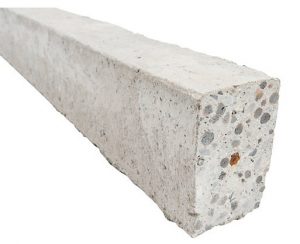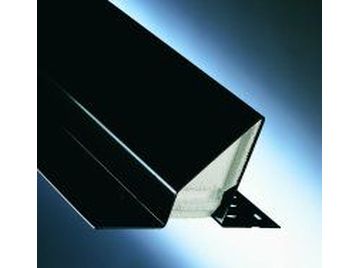If you are planning to add a doorway or window to a load-bearing wall, you will almost always be required to support the load of the wall above the planned opening with a lintel. Lintels can be made from a variety of materials, most commonly concrete or steel, and need to be fit for purpose. This guide looks at the different types of lintel available, where you might need to use them, and how to choose the correct type. You can read more about spanning openings with lintels in our guide to Spanning Openings in Brick Walls.
Do You Need a Lintel?
As previously mentioned, you will almost always need to support the wall above the opening you are planning. There are cases (if the opening is very narrow for example) where you will not be required to support the wall. In general, any opening more than 600mm wide will require a supporting lintel. If you are unsure, consult a local builder or building inspector, as exact regulations will vary between different countries.
Bear in mind that if the opening is in an external cavity wall, you will to either have a lintel that spans and supports each leaf of the cavity wall, or two separate lintels (one for each leaf of the wall).
Forces on a Lintel
The main forces that your chosen lintel must resist are tension and compression. As the load above pushes down onto the supporting beam and bends it, the bottom is being stretched and is under tension, whilst the top is being compressed. There is also a shearing force at the point where the lintel meets the supporting bricks, etc. Your choice of lintel type must be based on the amount of these forces.
Choosing a Lintel
There are several things to consider when deciding which type of lintel you will need for your opening. In all cases, if you are in doubt, it is better to use a lintel which is stronger than you need rather than the obviously disastrous alternative.
Wall construction – Is the wall load-bearing? Is it internal or external? Does it have a cavity? All these things and more can have a bearing on the type of support you require.
Width of Opening – Not all types of lintel are suitable for every opening width. Even in a non-loadbearing wall, a large opening can rule out the use of certain types. Remember that the lintel needs to be at least 300mm longer than the opening (150mm minimum for each end)
Consider the Load – You need to think about any masonry, roof trusses and joists which could possibly be exerting force on the lintel.
Working out the forces that the lintel will need to withstand is a tricky job. Unless you are very sure that you can work out the load accurately, it is always better to buy your lintel from a specialist builders merchant who should be able to advise you. You should also speak to your local planning officer for advice.
Get over 16000 woodworking plans. Learn how to build anything from furniture to birdhouses out of wood. Clear and detailed plans that guide you through the process of each project step-by-step.
Types of Lintel
The type of lintel you need will depend on a variety of factors, including the load it will need to support, how the doorway will be finished, as well as local building regulations. Here are the main types of lintel, and where they are most appropriate.
Wooden Lintels
 Wooden lintels are most often found on older houses (as well as timber-framed houses) either in the external wall or hidden behind a stone slab. Wooden lintels obviously run the risk of suffering from rot, but properly treated can last for a surprisingly long time.
Wooden lintels are most often found on older houses (as well as timber-framed houses) either in the external wall or hidden behind a stone slab. Wooden lintels obviously run the risk of suffering from rot, but properly treated can last for a surprisingly long time.
Unless you are going for a particular look with your property, or if you are replacing an existing wooden lintel, it is probably better to use one of the modern alternatives to wooden lintels.
Brick Lintels
Not used on their own, brick lintels are usually supported by stone, metal or wooden lintels over external doorways. Most often, a flat steel strip will support the bricks. The bricks are there for decoration rather than structural support. In some instances, bricks can be drilled through, and a supporting metal rod passed all the way through the holes and tied into the brickwork.
Natural Stone Lintels
Only suitable for smaller spans, stone lintels are usually found over external doorways of older houses. In most cases where a stone lintel has been used, a secondary wooden lintel will have been used behind it. Stone lintels on their own are poor under tension, so if you are considering using one, take advice on how much the lintel will need to support.
Concrete Lintels
 Concrete lintels usually have steel rods running the length of the beam to increase their strength under tension. You can buy pre-stressed concrete lintels, which are significantly lighter than standard concrete.
Concrete lintels usually have steel rods running the length of the beam to increase their strength under tension. You can buy pre-stressed concrete lintels, which are significantly lighter than standard concrete.
This type of concrete lintel is suitable for longer spans than the standard type, where the weight would make them difficult to handle. Concrete lintels are not very nice to look at, so are normally used where the lintel will be hidden.
Steel Lintels
Known as I-Beams, H-Beams, RSJ’s and sometimes Double T Beams. Most modern houses will have been constructed using pressed and galvanised steel lintels due to their strength, flexibility and ease of use. Steel lintels are widely used in both brick-built and wooden framed houses, and you can even buy them perforated, ready to be plastered directly on to.
Knocking two rooms into one would usually require a heavy-duty rolled steel joist due to the length of the span.
Specialist Lintels – Catnic
 Most applications will not need anything other than a standard steel or concrete lintel. However, there are several types of opening which might require a specialist lintel. You can buy specialist lintels from companies such as Catnic. These lintels include corrosion-proof coatings and even thermal insulation so that less heat is lost through these unavoidable breaks in the wall structure.
Most applications will not need anything other than a standard steel or concrete lintel. However, there are several types of opening which might require a specialist lintel. You can buy specialist lintels from companies such as Catnic. These lintels include corrosion-proof coatings and even thermal insulation so that less heat is lost through these unavoidable breaks in the wall structure.
Catnic provides lintels for a wide variety of uses including under-eave lintels, cavity wall lintels, Corner lintels, timber frame lintels and heavy-duty or extreme load lintels. For a full list of the specialist and non-specialist lintels that Catnic can provide, you can visit their website at http://www.catnic.com/.
Cavity Lintels
Cavity lintels are designed, as the name suggests, to fit into the cavity of an external wall and can be used to span both window or door openings. The wedge shape (see the image above) helps to carry any water in the cavity to the outside skin rather than letting it penetrate the inner skin (and therefore your home).







